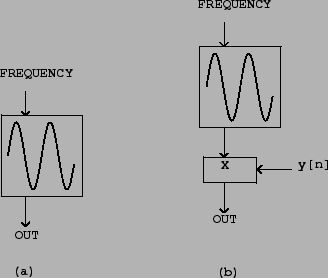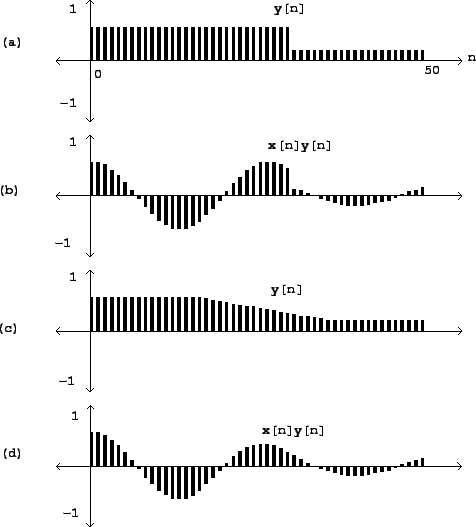 |
In most widely used audio synthesis and processing packages (Csound, Max/MSP, and Pd, for instance), the audio operations are specified as networks of unit generators which pass audio signals among themselves. The user of the software package specifies the network, sometimes called a patch, which essentially corresponds to the synthesis algorithm to be used, and then worries about how to control the various unit generators in time. In this section, we'll use abstract block diagrams to describe patches, but in the "examples" section later, we'll have to choose a real implementation environment and show some of the software-dependent details.
To show how to produce a sinusoid with time-varying amplitude we'll need to introduce two unit generators. First we need a pure, SINUSOID which is produced using an oscillator. Figure 1.2(a) shows the icon we use to show a sinusoidal oscillator. The input is a frequency (in cycles per second), and the output is a SINUSOID of peak amplitude one.
 |
Figure 1.2(b) shows how to multiply the output of a sinusoidal
oscillator by an appropriate amplitude scaler ![]() to control its amplitude.
Since the oscillator's peak amplitude is 1, the peak amplitude of the product
is about
to control its amplitude.
Since the oscillator's peak amplitude is 1, the peak amplitude of the product
is about ![]() , assuming
, assuming ![]() changes slowly enough and doesn't become
negative in value.
changes slowly enough and doesn't become
negative in value.
 |
Figure 1.3 shows how the SINUSOID of Figure 1.1 is
affected by amplitude change by two different controlling signals ![]() . In
the first case the controlling signal shown in (a) has a discontinuity, and so
therefore does the resulting amplitude-controlled sinusoid shown in (b). The
second case (c, d) shows a more gently-varying possibility for
. In
the first case the controlling signal shown in (a) has a discontinuity, and so
therefore does the resulting amplitude-controlled sinusoid shown in (b). The
second case (c, d) shows a more gently-varying possibility for ![]() and the
result. Intuition suggests that the result shown in (b) won't sound like an
amplitude-varying sinusoid, but instead by a sinusoid interrupted by a fairly
loud ``pop" after which the sinusoid reappears more quietly. In general, for
reasons that can't be explained in this chapter, amplitude control signals
and the
result. Intuition suggests that the result shown in (b) won't sound like an
amplitude-varying sinusoid, but instead by a sinusoid interrupted by a fairly
loud ``pop" after which the sinusoid reappears more quietly. In general, for
reasons that can't be explained in this chapter, amplitude control signals
![]() which ramp smoothly from one value to another are less likely to give
rise to parasitic results (such as the ``pop" here) than are abruptly changing
ones. Two general rules may be suggested here. First, pure sinusoids are the
class of signals most sensitive to the parasitic effects of quick amplitude
change; and second, depending on the signal whose amplitude you are changing,
the amplitude control will need between 0 and 30 milliseconds of ``ramp"
time--zero for the most forgiving signals (such as white noise), and 30 for
the least (such as a sinusoid). All this also depends (in complicated ways)
on listening levels and the acoustic context.
which ramp smoothly from one value to another are less likely to give
rise to parasitic results (such as the ``pop" here) than are abruptly changing
ones. Two general rules may be suggested here. First, pure sinusoids are the
class of signals most sensitive to the parasitic effects of quick amplitude
change; and second, depending on the signal whose amplitude you are changing,
the amplitude control will need between 0 and 30 milliseconds of ``ramp"
time--zero for the most forgiving signals (such as white noise), and 30 for
the least (such as a sinusoid). All this also depends (in complicated ways)
on listening levels and the acoustic context.
Suitable amplitude control functions ![]() may be obtained using an
envelope generator. Figure 1.4 shows a network in which an
envelope generator is used to control the amplitude of an oscillator.
Envelope generators vary widely in functionality from one design to another,
but our purposes will be adequately met by the simplest kind, which generates
line segments, of the kind shown in fig. 1.2(b). If a line
segment is specified to ramp between two output values
may be obtained using an
envelope generator. Figure 1.4 shows a network in which an
envelope generator is used to control the amplitude of an oscillator.
Envelope generators vary widely in functionality from one design to another,
but our purposes will be adequately met by the simplest kind, which generates
line segments, of the kind shown in fig. 1.2(b). If a line
segment is specified to ramp between two output values ![]() and
and ![]() over
over ![]() samples starting at sample number
samples starting at sample number ![]() , the output is:
, the output is:
In addition to changing amplitudes of sounds, amplitude control is often used, expecially in real-time applications, simply to turn sounds on and off: to turn one off, ramp the amplitude smoothly to zero. Most software synthesis packages also provide ways to actually stop modules from computing samples at all, but here we'll use amplitude control instead.
Envelope generators are described in more detail in section 4.1.